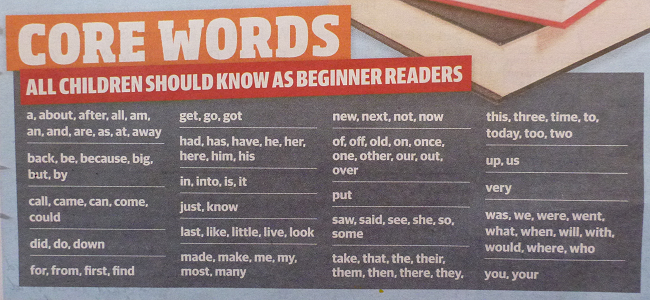This is the letter to the editor that I wrote in reply to an article about core words in learning to read in our local newspaper. It will be interesting to see if they publish it all, or any of it. It may well just be too long.
In the Literacy Counts article in Newspapers in Education (The Mercury, 1 August, 2017), a list of core words that all children should know as beginner readers included 109 words. This might give the idea that children should just have to remember them, i.e. just learn them as whole words. This approach to learning to read leads to memory overload, developing less efficient pathways in the brain for reading, 25% of children failing and another 25% needing a lot of help.
If however you start by teaching children the most common sound of each letter and how to blend them together to make words, they will be able to read 25 of the words in the list easily, plus hundreds of other words. The second sound of “s” = /z/ (as, his) adds 4 more words, magic “e” another 6, the 2nd and 3rd sound of “y” (happy, my) another 6. “A vowel on the end of a short word often says its name” (be, go) adds 6 words, or perhaps “If the sound of a vowel doesn’t work, try its name” adds one more.
Then if you teach the sound of some common groups of letters, e.g. ee, er, ir, ar, or, wh, 2 sounds of “oo” (look, hoops), the most common sound of “ou” (out), 2 sounds of “ow” (/ow/ when someone pinches you, and in show), 2 sounds of “th”, aw, ew, all, and kn = /n/, adds 21 more.
The second sound of “ou” (soup) and two common words where the “e” doesn’t do anything add the important words, “you”, “are” and “were”. This brings us up to 72 out of the 109 words being totally straight forward.
Add a few more rules like “Beware of ‘w’!” (was, what), the third sound of “a” (after), the 4th sound of “o” (do, to), the 2nd sound of “wh” (who) and we have added 8 more. Now we are up to 80 out of the 109 of these core words.
There is helpful background for all of the remaining words, but if you just ask your child which parts of a word are easy and which parts are tricky, you will be able to help them without overloading their memory. E.g. in “said”, the first and last letters are easy, but “ai” is tricky. Tell them the word, then “How can we help you remember this?” Perhaps, “Pay/paid, lay/laid and say/said follow the same spelling pattern, but the pronunciation is different,” or make up some other sort of memory aid like “I said I had paid you.”
Sharing a love of reading, reading out loud, finding interesting books, talking about the story, etc. are really important. But if you actually want to teach your child to read, or help a child who is struggling, systematic, synthetic phonics is by far the best approach.”Synthetic” because you teach the sounds of letters and groups of letters, then blend (synthesise) the sounds to make words. This will develop the most efficient neural pathways and allow every child to learn to read successfully (except obviously profoundly deaf children). It is particularly important for and successful with children from a poor background.





{ 0 comments… add one now }